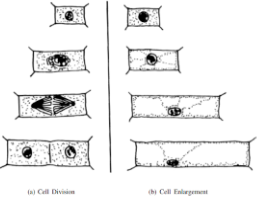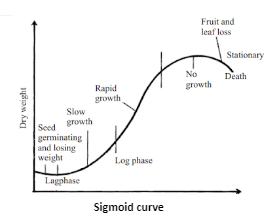Plants, like animals and people, increase in height and size over time. However, how can plants reproduce? How do flowers and fruits emerge and fall on a tree’s branches? All of these periodic occurrences occur in an orderly fashion in plants, from the zygote stage to the fully developed plant, and are referred to as growth and development.
Plant Growth
All living organisms exhibit the essential trait of growth. It is a permanent and irreversible metabolic process. Whether it is a plant, an animal, a bird, or an insect, every living species, from the simplest to the most sophisticated, undergoes the process of growth-increasing in size.
Plants are unusual in their capacity to develop continuously throughout their lives. The whole process of plant growth and development is orchestrated by specialised cells called meristems.
Phases of Growth in Plants
Growth occurs in three stages: meristematic, elongation, and maturity. We can better grasp this by examining a seed. As previously stated, the tips of roots and shoots develop continuously and are hence meristematic. This region’s cells are protoplasm-rich and have big nuclei. The cells next to this area are in the elongation phase of growth. This area is where new cell walls, vacuoles, and other structures are formed. The interval immediately before the elongation phase is the maturation phase, during which the cells reach their maximum size.
Growth and Development
The growth of living creatures is not constant throughout the course of their lives. Growth accelerates until the plants or animals reach maturity. Then it slows down and eventually comes to a halt. Death happens later in life. All of these changes that occur in an organism from birth to death are generally referred to as development. Morphogenesis and differentiation are both involved in development. Morphogenesis is the process by which an organism develops its shape and structure, whereas differentiation is the process by which cells, tissues, or organs change in order to perform various roles.
Development is the process through which an organism experiences qualitative and quantitative changes such as growth, differentiation, and maturation during the course of its existence.
Stages of Cellular Growth
You have previously learned that an organism’s growth is always accompanied by an increase in the size and number of cells. An organ or organism grows in three phases. They are:
(I) Cell division: Mitosis results in an increase in the number of cells.
(ii) Cell enlargement: After cell division, the size of an individual cell grows owing to an increase in the amount of its protoplasm.
(iii) Cell differentiation: During this stage, the cells’ shape changes to accommodate certain roles. And comparable types of cells with similar tasks create a group called tissue.
The whole body develops in lower creatures such as bacteria and algae. However, in higher organisms such as ferns, pine trees, and flowering plants, growth is confined to cells located in growing areas such as the shoot apex and root tip, as well as near to the stem and root’s lateral sides. Growth at the tips results in the elongation of body parts, whereas growth lateral (sideways) results in the thickening of the stem and root.
A plant or plant component does not necessarily develop at the same pace throughout its life. It might be gradual at times and quick at others. When we plot the rise in cell number (growth rate) versus time, we get a characteristic S-shaped curve. This kind of curve is referred to as a growth curve or sigmoid growth curve.
This curve grows in three stages:
(I) Lag Phase – This is the first phase of growth during which the growth rate is very sluggish.
(ii) Log Phase – It exhibits fast growth and is at its peak throughout the lifespan.
(iii) Stationary Phase – At this point, the rate of development begins to slow and eventually ceases.
Sigmoid curve
The whole-time span during which an organ or organism grows at its fastest rate is referred to as the grand period of growth.
Factors Affecting Plants Growth
External influences are those in the environment that have an effect on the development of plants, either directly or indirectly. These variables include
(I) light and (ii) temperature (iii) Mineral nutrients (iv) Water
Light
You have previously learned about the critical role of light in the photosynthesis process. Apart from photosynthesis, light is required for seed germination, seedling development, tissue and organ differentiation, and reproduction.
When plants develop in the dark, they become tall, yellowish, and frail, with extremely little leaves
Temperature
Certain plants thrive in cold climates, while others thrive in hot climates. The optimal temperature for plant development is between 28-30°C, however it may occur between 4 and 45°C. Temperature fluctuation has a direct effect on all metabolic processes of plants. Extremely low temperatures cause injury to the plant by chilling and freezing, while extremely hot temperatures cause it to cease growing
Mineral Nutrients
Inorganic nutrients are required for all metabolic activities. Nutrient deprivation has a detrimental effect on plant development
Water
You already know that a plant takes water through its roots, utilises it for photosynthesis and other biochemical activities, and loses part of it via transpiration. Plants need a certain amount of water to develop properly. Both a lack of water and an overabundance of water impede plant development
Internal Growth Factors
Along with the external elements outlined above, there are several compounds created inside the plant body that impact the plant’s development. These substances are referred to as plant hormones, phytohormones, or growth hormones. A phytohormone is an organic compound generated in trace amounts in one area of the plant’s body and capable of spreading to other sections to impact that portion’s development.
Plant development may also be regulated by some synthetic compounds that are structurally and functionally similar to plant hormones. These substances are referred to as growth regulators. They are not generated naturally by plants.
Growth regulators are chemical compounds that, in addition to naturally occurring hormones, encourage, hinder, or change plant growth and development.
The five primary types of naturally occurring growth hormones are as follows. They really are.
(I) Auxin
(ii) Gibberellins
(iii) Cytokinin
(iv) Ethylene
(v) Abscissic acid
Arithmetic Growth Formula
The formula of arithmetic growth rate is:
Lt = L0 + rt
Lt –the Length at time ‘t’
L0 – the Length a time ‘zero’
r – the Growth rate or the elongation per unit time
Conclusion
Growth is a necessary, natural, and unstoppable process. Every plant grows like a living organism, however unlike humans, plants have distinct growth characteristics. They continue to develop throughout their lives. Plants grow in a predictable and orderly manner. Plant development is defined as a methodical mannerism of growth.
Plant growth refers to an increase in the size of plant parts, organs, tissue, the entire plant, or a single cell that is irreversible and permanent. Growth, like any other living entity, is the most basic property of living plants. Plant growth is accompanied by metabolic processes that involve energy expenditure, such as catabolism and anabolism.
 Profile
Profile Settings
Settings Refer your friends
Refer your friends Sign out
Sign out






